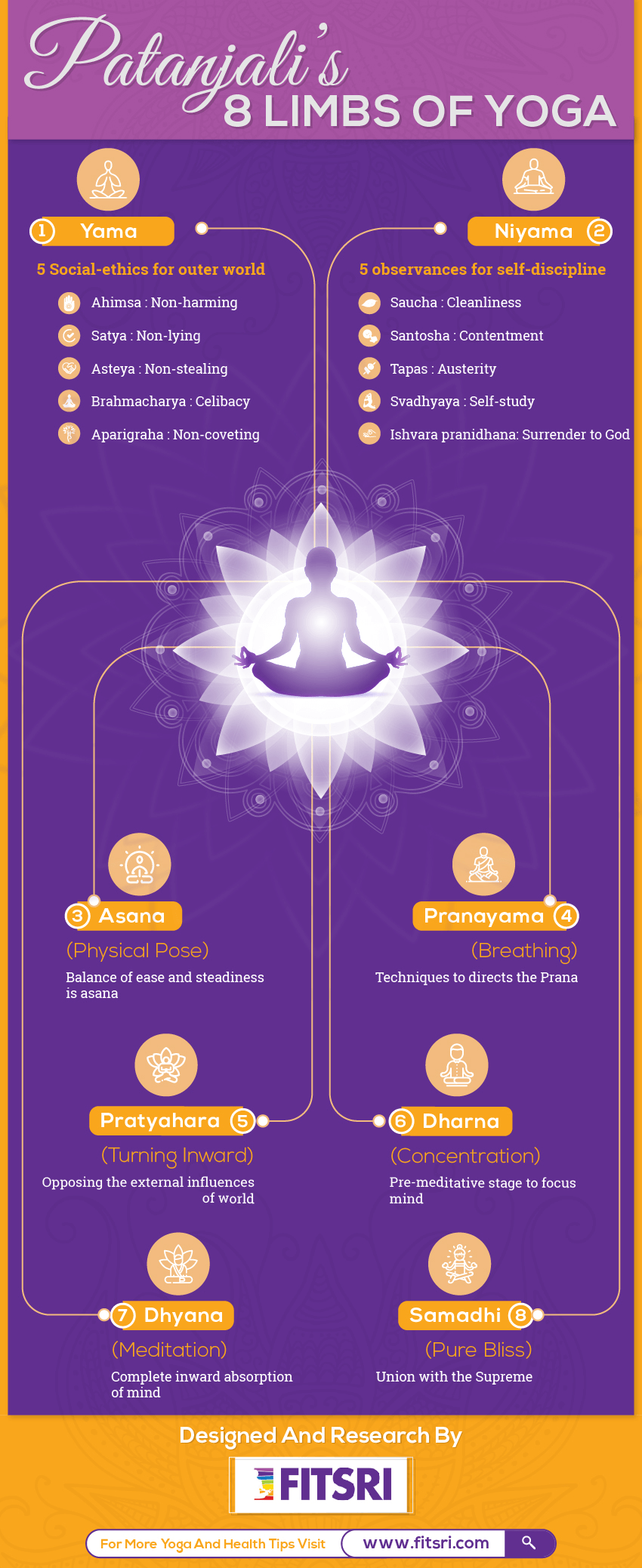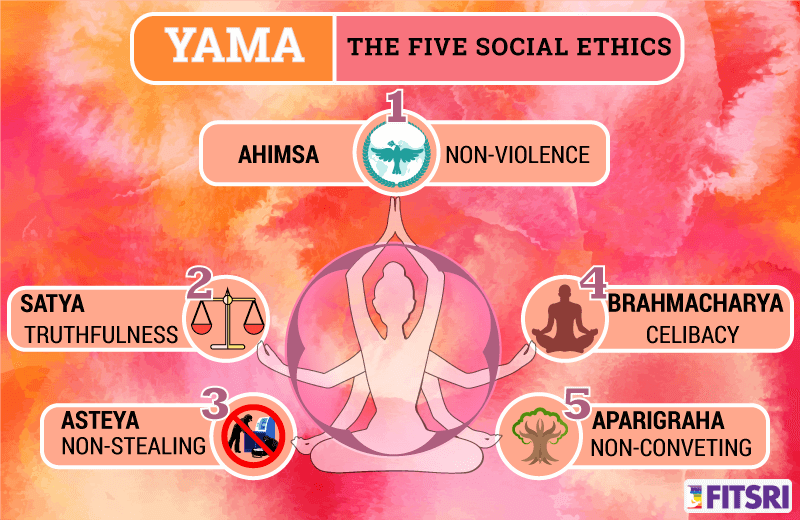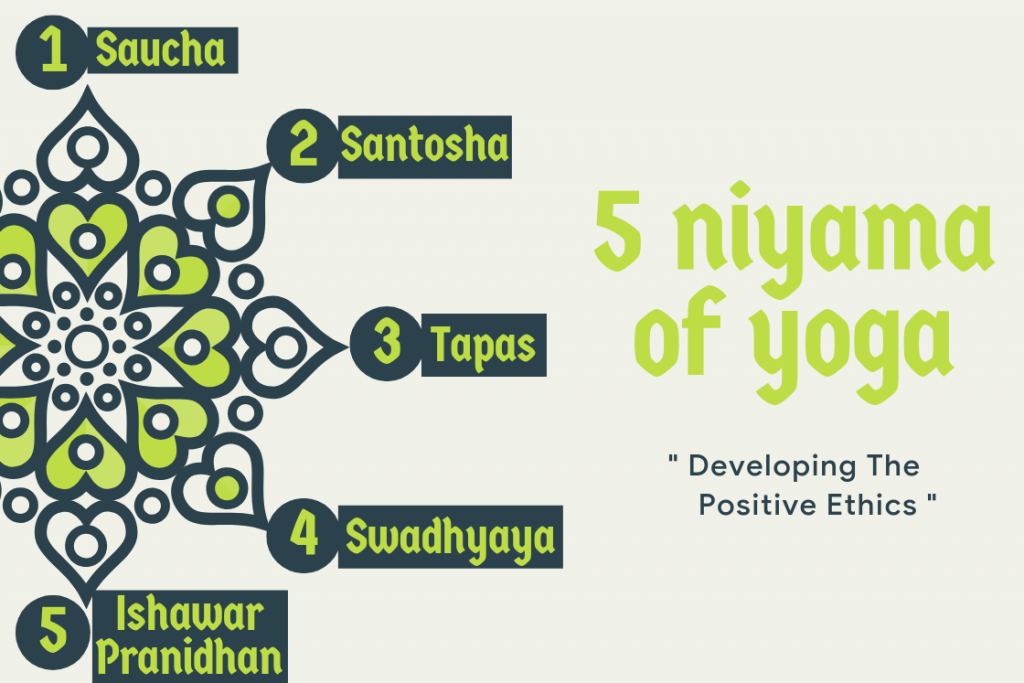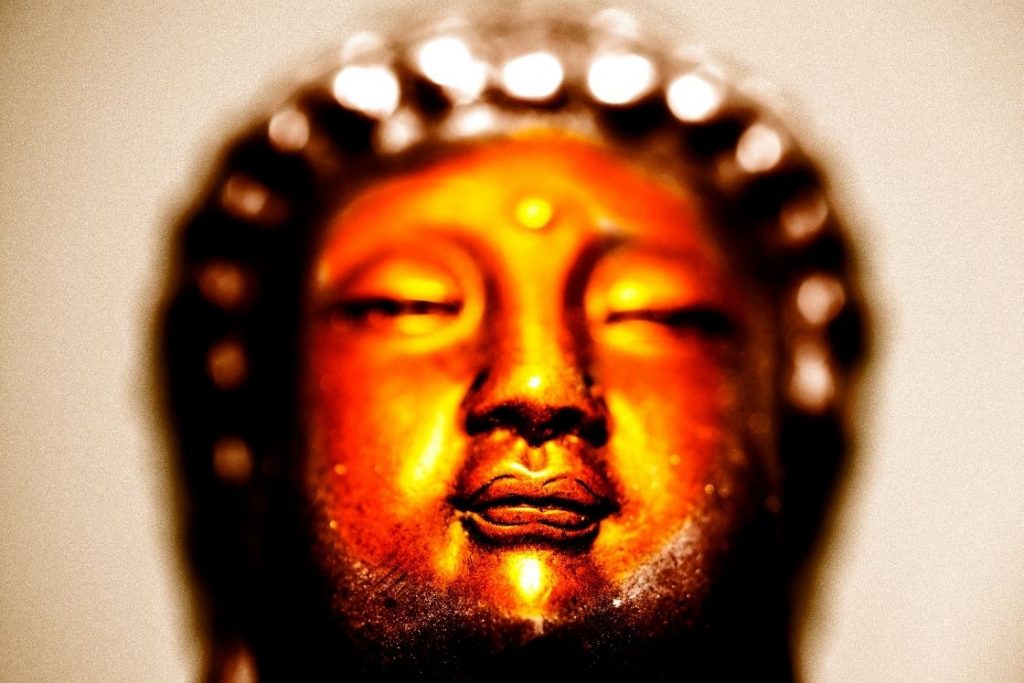
At the heart of spirituality of yoga, the “8 Limbs of Yoga,” is a systematic and practical framework introduced by the sage Patanjali in his revered text, the Yoga Sutras.
In this comprehensive guide, we will not only know what are the 8 limbs of yoga but also delve into the essence of each limb: the purpose they serve and provide you with practical insights on how to incorporate them into your yoga practice.
These eight limbs form the cornerstone of yoga philosophy, encompassing moral, physical, spiritual, and practical aspects. By understanding their significance and embracing them as integral components of your yoga journey, you can unlock profound inner growth and achieve a heightened state of consciousness.
Understanding the 8 Limbs of Yoga
Patanjali’s Yoga Sutras is a text of wisdom that illuminates the path to self-realization. At its core lie the “8 Limbs of Yoga,” which are a roadmap for individuals seeking to deepen their connection with themselves through systematic practice of yoga.

The eight limbs of yoga are Yama (Restraints), Niyama (Observances), Asana (Posture), Pranayama (Breath Control), Pratyahara (Withdrawal of the Senses), Dharana (One-pointed concentration), Dhyana (Meditation), and Samadhi (Pure bliss).
Purpose of the 8 Limbs
- The primary purpose of the 8 Limbs of Yoga is to lead practitioners toward Samadhi, the final 8th limb, where pure bliss and self-realization reside.
- 8 limbs serve as a structured approach to living a more conscious, meaningful, and harmonious life. Indeed they make the foundation of a yogic lifestyle.
- By practicing the 8 Limbs, one can transcend the limitations of the physical world, attaining higher states of consciousness and understanding the interconnectedness of all beings.
How to Practice the 8 Limbs?
- Each limb is a stepping stone, and while they are interconnected, they can also be individually cultivated.
- To practice the 8 Limbs effectively, it’s crucial to integrate them into your daily life.
- As we proceed through this guide, we will explore each limb in detail, offering insights and practical tips on how to incorporate them into your yoga journey.
Prepare to embark on a transformative exploration of the 8 Limbs of Yoga. We will delve into the purpose behind each limb and provide you with actionable steps to weave them into your practice, enriching your life both on and off the mat.
Yama: The First Limb (Social Ethics)

The journey through the 8 Limbs of Yoga begins with Yama, the first limb that lays the foundation for ethical and moral conduct in our lives. Yama can be seen as a set of guidelines, often referred to as “social ethics,” that shape our interactions with the external world. It encompasses a profound sense of responsibility toward others and the world around us.
Purpose of Yama
- Yama serves as a moral compass, directing us towards right conduct and harmonious relationships.
- It encourages us to cultivate qualities that promote peace, compassion, and integrity.
- The purpose of Yama is to create a solid ethical foundation, allowing us to progress through the subsequent limbs with a clear and guilt-free conscience.
How to Practice Yama?
- Yama consists of five key principles, known as the “5 Yamas,” each addressing a specific aspect of ethical conduct.
- To practice Yama effectively, one must self-reflect and consciously apply these principles in daily life.
- Let’s delve into each Yama to understand their significance and learn how to incorporate them into our interactions with the world
- Ahimsa (Non-harming)
- Satya (Truthfulness)
- Asteya (Non-stealing)
- Brahmacharya (Celibacy)
- Aparigraha (Non-coveting)
Feel free to explore the depths of each Yama by clicking on the above links. Each yama guide unravel its meaning and practical guidance on how to embrace them in your daily existence. By understanding and embodying Yama, you take the first step on the path to self-realization and a more compassionate way of being.
Niyama: The Second Limb (Observances)

As we progress on our journey through the 8 Limbs of Yoga, we encounter Niyama, the second limb. Niyama represents a set of observances, offering guidelines for self-discipline and personal growth. Just as Yama focuses on our ethical conduct towards the external world, Niyama directs our attention inwards, shaping our relationship with ourselves.
Purpose of Niyama
- Niyama encourages self-purification and self-improvement, fostering a sense of inner harmony and balance.
- It serves as a roadmap for developing qualities like contentment, self-discipline, and self-reflection.
- The purpose of Niyama is to prepare the inner landscape, making it fertile ground for the practices of the subsequent limbs.
How to Practice Niyama?
- Niyama comprises five essential observances, each designed to nurture your inner world.
- To practice Niyama effectively, cultivate these observances as daily habits, allowing them to become an integral part of your life.
- Let’s explore the five Niyamas in-depth, understanding their significance, and discovering how they can enhance your inner journey:
- Shaucha (Cleanliness)
- Santosha (Contentment)
- Tapas (Austerity)
- Svadhyaya (Self-study)
- Ishvara pranidhana (Surrender to God)
By practicing Niyama, you deepen your connection with your inner self and thus embark on a path of self-discovery and personal growth.
Asana: The Third Limb (Physical Posture)

With a solid foundation in ethical conduct (Yama) and self-observance (Niyama), we move forward to Asana, the third limb of the 8 Limbs of Yoga. Asana translates to “physical posture” and is often the aspect of yoga that first comes to mind. However, in the context of the 8 Limbs, Asana is much more than striking impressive poses; it is about finding stillness of body and mind in any posture.
Purpose of Asana
- Asana aims to cultivate physical strength, flexibility, and balance, preparing the body for deeper yogic practices.
- It serves as a means to calm the mind by aligning breath and movement, fostering mindfulness.
- The purpose of Asana is to create a healthy and balanced physical foundation, allowing the practitioner to sit comfortably for meditation and inner exploration.
How to Practice Asana?
- Asana involves a wide range of physical postures, from simple stretches to more advanced poses.
- To practice Asana effectively, it’s crucial to approach it with mindfulness, focusing on the breath and maintaining a sense of ease.
- While Patanjali’s Yoga Sutra mentions meditative postures, modern yoga includes a wide variety of poses that promote physical well-being.
Pranayama: The Fourth Limb (Breathing Techniques)

As we ascend the path of the 8 Limbs of Yoga, we arrive at Pranayama, the fourth limb. Pranayama is the art of harnessing the breath, the Prana (life force) that flows within and around us. It involves various breathing techniques and exercises designed to regulate and expand our breath, unlocking a deeper connection between the body and the mind.
Purpose of Pranayama
- Pranayama is a powerful practice for enhancing the flow of prana (vital energy) within the body, promoting physical and mental well-being.
- It aids in calming the mind, reducing stress, and preparing the practitioner for meditation.
- The purpose of Pranayama is to develop breath awareness, directing it to different regions of the body, and ultimately, to reach higher states of consciousness.
How to Practice Pranayama?
- Pranayama includes a variety of breathing techniques, from simple breath awareness to advanced practices like Ujjayi, Kapalabhati, and Nadi Shodhana.
- To practice Pranayama effectively, one must start with basic techniques and gradually progress under the guidance of a skilled teacher.
- The integration of breath control into your yoga practice enhances its transformative power.
Pratyahara: The Fifth Limb (Turning Inward)

Pratyahara, the fifth limb of the 8 Limbs of Yoga, marks a significant shift in our journey. It is the practice of turning inward, withdrawing our senses from the external world and redirecting them toward our inner landscape. Pratyahara serves as a bridge, linking the external cleansing practices to the internal ones, preparing the mind for deeper exploration.
Purpose of Pratyahara
- Pratyahara is about gaining mastery over our senses and their constant outward-seeking tendencies.
- It provides a gateway to silence the distractions of the external world, allowing us to journey deeper into meditation.
- The purpose of Pratyahara is to bring awareness within, creating a serene and focused inner environment.
How to Practice Pratyahara?
- Pratyahara involves consciously withdrawing the senses from their usual objects of desire.
- To practice Pratyahara effectively, one must cultivate mindfulness and observe the senses without attachment or aversion.
- This practice prepares the mind for the advanced limbs of Dharana (Concentration) and Dhyana (Meditation).
By mastering Pratyahara, you create the necessary stillness and focus for the profound inner experiences that lie ahead on your yogic journey.
Dharana: The Sixth Limb (Concentration)

As we progress through the 8 Limbs of Yoga, we arrive at Dharana, the sixth limb. Dharana signifies the practice of concentration, where the mind becomes less scattered and more focused. It is a pivotal step in the journey of self-realization, as it allows us to direct our attention to a single point or object, reducing mental distractions.
Purpose of Dharana
- Dharana aims to harness the wandering mind, bringing it under control and preventing it from drifting.
- It is a preparatory stage for deeper meditation (Dhyana), as sustained concentration is required to delve into the depths of consciousness.
- The purpose of Dharana is to refine the mind’s ability to remain still and centered.
How to Practice Dharana?
- Dharana involves focusing the mind on a chosen object or point of attention.
- To practice Dharana effectively, choose a point of concentration, such as a mantra, a candle flame, or the breath, and gently guide your awareness to that point.
- As distractions arise, gently bring your focus back to the chosen object.
By mastering Dharana, you develop the mental fortitude needed to delve deeper into the realms of meditation and self-discovery.
Dhyana: The Seventh Limb (Meditation)

Dhyana, the seventh limb of the 8 Limbs of Yoga, represents the profound practice of meditation. After achieving mastery over concentration (Dharana), we enter the state of Dhyana, where the mind becomes still and fully absorbed in the object of meditation. This is where the true exploration of the inner self begins.
Purpose of Dhyana
- Dhyana is the gateway to self-realization, allowing us to dive deep into the realms of consciousness and explore the true nature of our being.
- It is a practice of inner transformation, where the meditator transcends the ego and experiences a state of pure awareness.
- The purpose of Dhyana is to connect with the divine source within and attain a profound sense of peace and unity.
How to Practice Dhyana?
- Dhyana involves meditating on a chosen object or mantra, maintaining a continuous flow of awareness without interruption.
- To practice Dhyana effectively, cultivate patience and consistency in your meditation practice.
- It is essential to let go of expectations and judgments during meditation, allowing the mind to enter a state of pure awareness.
By mastering Dhyana, you open the door to inner transformation and a profound connection with your true self.
Samadhi: The Eighth Limb (Pure Bliss)

In the journey through the 8 Limbs of Yoga, we reach the pinnacle: Samadhi, the eighth and final limb. Samadhi represents the state of pure bliss and self-realization. It is the culmination of the yogic path, where the practitioner merges with the universal consciousness, transcending the limitations of the individual self.
Purpose of Samadhi
- Samadhi is the ultimate goal of yoga, where the practitioner experiences a state of oneness with the universe, free from the ego’s constraints.
- It leads to liberation (moksha) from the cycle of birth and death, bringing eternal peace and contentment.
- The purpose of Samadhi is to realize the true nature of the self and experience a profound sense of unity, love, and bliss.
How to Attain Samadhi?
- Samadhi cannot be achieved through effort alone; it is a state of grace that arises when the mind is pure, focused, and free from desires.
- To cultivate the conditions for Samadhi, one must diligently practice the preceding limbs, including Yama, Niyama, Asana, Pranayama, Pratyahara, Dharana, and Dhyana.
- Surrender to the divine and let go of attachment to the fruits of your actions.
By aspiring toward Samadhi, you embark on a journey of self-discovery and spiritual awakening, transcending the boundaries of the self to experience pure bliss and unity with the universe.
Conclusion
The 8 Limbs of Yoga, as expounded by the sage Patanjali in the Yoga Sutras, represent a profound and comprehensive path to self-realization, inner peace, and spiritual awakening. This ancient system offers a roadmap for individuals seeking balance, purpose, and a deeper understanding of their true selves.
The significance of the 8 Limbs of Yoga extends far beyond the yoga mat. These principles can be integrated into your daily life, guiding you towards a life of mindfulness, compassion, and self-awareness.
Incorporate 8 limbs one step at a time, starting with Yama and Niyama (ethical principles), gradually progressing through Asana (physical postures), Pranayama (breath control), Pratyahara (turning inward), Dharana (concentration), Dhyana (meditation), and ultimately, Samadhi (pure bliss).
FAQs About the 8 Limbs of Yoga
The 8 Limbs of Yoga provide a comprehensive guide to living a balanced and purposeful life, leading to self-realization and inner peace.
While the limbs are traditionally practiced sequentially, some flexibility exists. However, mastering each limb before moving to the next is recommended for a strong foundation.
Start by integrating Yama and Niyama (ethical principles) into your daily interactions. Gradually add Asana, Pranayama, and meditation practices. Consistency is key.
While a knowledgeable teacher or guru can provide guidance, self-study and self-discipline are essential. Many practitioners find mentors or teachers helpful but not mandatory.
Yes, the 8 Limbs serve as a foundational framework for all paths of yoga, including Hatha, Ashtanga, Vinyasa, and others.





really it’s a piece of valuable information. I feel so happy while reading these topics. keep it up, gentlemen.
valuable information, keep writing Ashish.
One thing I want to ask, what is the relation between Ashtanga yoga & 8 limbs of yoga?
Are they both same?
Hello, thank you Maria.
you can say 8 limbs & Ashtanga yoga is same. Patanjali proposed 8 limbs of yoga in his classical text yoga sutra around 400 CE. ashtanga yoga is the practice based on tenets of 8 limbs given by k.pattabhi jois in the early 19th century.